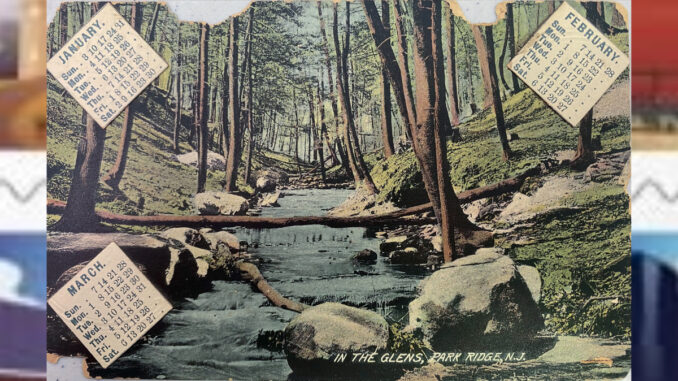
PASCACK VALLEY—Happy New Year, Pascack Valley! As we trade our 2023 calendars for hot-off-the-press 2024 versions, let’s take a look at a unique piece of ephemera from the collection of the Pascack Historical Society. This postcard, showing a scene on the Bear Brook in the Glen, features three miniature calendars for January through March.
We know the months, but what was the year? This card was never mailed, and thus it has no postmark to assign it an age. The image also gives no clues—our beautiful Atkins Glen has changed little over the past century, and a similar view could be captured in 2024. Fortunately, there is much to be learned elsewhere on this object.
This postcard has a divided back: one side was for the message, and the other was for the recipient’s address. It is the same format that is familiar to us today, but the U.S. Postal Service did not allow it until 1907. People greatly preferred this over the previous style, in which the back of the postcard was for the address only and the message had to be squeezed onto the front.
Further, we know the postcard dates to before 1915, because it was printed in Germany.
It might seem odd that a postcard with a scene from Park Ridge, intended to be sold in Park Ridge, would be printed overseas, especially in those days when shipping items took so much longer.
According to the New York Public Library, “Early postcards were typically printed in Germany, where the art of lithography had reached a level of refinement and cost-effectiveness not found elsewhere. The high quality of printing enticed the public to collect the cards, and assured artists that their work would be reliably and attractively reproduced.”
Approximately 75% of the postcards sold in America in the early 1900s were printed in Europe. Then, in 1914, World War I ended the supply of postcards coming from Germany.
With our timeline narrowed to between 1907 and 1914, we take a look at the calendars themselves. We can see that the year started on a Friday, which fits the bill for only two years during that span: 1904 and 1909. We can rule out the former, as it was a leap year, and say with some certainty that the postcard was intended to be mailed in January 1909.
Many Pascack Valley scenes were committed to postcards in the early 1900s, and one of the popular subjects was the spot we now know as Atkins Glen. Back then it was called Leach’s Glen, named for landowner James Leach, a prominent Park Ridge citizen and early mayor who had a beautiful mansion on Fremont Avenue.
The Glen has been a part of the culture of the Pascack Valley for generations. A deep ravine cut through the sandstone by the Bear Brook, the spot is a rare natural gem in the middle of our suburban landscape. Even in the early 1900s, when the area was still very rural, the beauty of the Glen made it a favorite spot for walks and picnics. It exists today, largely unchanged, thanks to successive owners who refused to let the modern world mar a natural wonder—first James Leach, and later Daniel H. Atkins of Montvale, who bought the property in 1921.
In the 1950s the Atkins estate gifted the land to the Borough of Park Ridge for use as a public park.About 75% of the postcards sold in America in the early 1900s were printed in Europe. Then, in 1914, World War I ended the supply of postcards coming from Germany.
